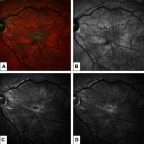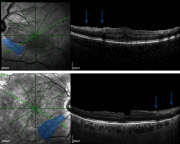Idiopathic epiretinal membrane surgery: safety, efficacy and patient related outcomes
- PMID: 31409964
- PMCID: PMC6643061
- DOI: 10.2147/OPTH.S176120
Idiopathic epiretinal membrane surgery: safety, efficacy and patient related outcomes
Abstract
This review aims to give to the reader an overview selectively oriented on safety and efficacy of surgery, providing concise and direct answers about crucial questions of trainees and experts. Surgery for idiopathic epiretinal membrane (ERM) is a safe and effective procedure that can achieve long-term stable postoperative visual and anatomical improvement, with an overall low recurrence and complication rate. Young patients, with a short onset of symptoms and with better initial visual acuity achieve higher levels of visual outcome. The preoperative degree of metamorphopsia is the prognostic factor for their postoperative degree. Successful results may be obtained in eyes with specific optical coherence tomography criteria, such as thin ganglion cell layers, thin internal plexiform layer, longer photoreceptors outer segment, regular ellipsoid zone and cone outer segment tips line, and without ectopic inner foveal layer. Internal limiting membrane peeling demonstrates positive anatomical and functional outcomes, but final positions about its safety remain controversial.
Keywords: efficacy; idiopathic epiretinal membrane; outcome; prognostic factor; safety.
Conflict of interest statement
Professor Francesco Bandello reports personal fees from Allergan, Bayer, Boehringer-Ingelheim, Fidia Sooft, Hofmann La Roche, Novartis, NTC Pharma, Sifi, Thrombogenics, and Zeiss, outside the submitted work. The authors report no other conflicts of interest in this work.
Figures




Similar articles
-
Photoreceptor change and visual outcome after idiopathic epiretinal membrane removal with or without additional internal limiting membrane peeling.Retina. 2014 Jan;34(1):172-81. doi: 10.1097/IAE.0b013e318295f798. Retina. 2014. PMID: 23743638
-
Preferential hyperacuity perimeter and prognostic factors for metamorphopsia after idiopathic epiretinal membrane surgery.Am J Ophthalmol. 2013 Jan;155(1):109-117.e3. doi: 10.1016/j.ajo.2012.07.007. Epub 2012 Sep 27. Am J Ophthalmol. 2013. PMID: 23022166
-
FUNCTIONAL AND ANATOMICAL SIGNIFICANCE OF THE ECTOPIC INNER FOVEAL LAYERS IN EYES WITH IDIOPATHIC EPIRETINAL MEMBRANES: Surgical Results at 12 Months.Retina. 2019 Feb;39(2):347-357. doi: 10.1097/IAE.0000000000001940. Retina. 2019. PMID: 29160787
-
THE EFFECT OF INTERNAL LIMITING MEMBRANE PEELING ON IDIOPATHIC EPIRETINAL MEMBRANE SURGERY, WITH A REVIEW OF THE LITERATURE.Retina. 2017 May;37(5):873-880. doi: 10.1097/IAE.0000000000001263. Retina. 2017. PMID: 27617536 Review.
-
Vitrectomy with or without internal limiting membrane peeling for idiopathic epiretinal membrane: A meta-analysis.PLoS One. 2017 Jun 16;12(6):e0179105. doi: 10.1371/journal.pone.0179105. eCollection 2017. PLoS One. 2017. PMID: 28622372 Free PMC article. Review.
Cited by
-
Variability of Visual Recovery with Time in Epiretinal Membrane Surgery: A Predictive Analysis Based on Retinal Layer OCT Thickness Changes.J Clin Med. 2023 Mar 8;12(6):2107. doi: 10.3390/jcm12062107. J Clin Med. 2023. PMID: 36983110 Free PMC article.
-
Presumed Combined Brilliant Blue G and Endolight-Induced Macular Damage following Epiretinal Membrane Removal Surgery.J Curr Ophthalmol. 2022 Jul 26;34(2):267-270. doi: 10.4103/joco.joco_46_22. eCollection 2022 Apr-Jun. J Curr Ophthalmol. 2022. PMID: 36147266 Free PMC article.
-
Idiopathic epiretinal membrane: progression and timing of surgery.Eye (Lond). 2022 Mar;36(3):495-503. doi: 10.1038/s41433-021-01681-0. Epub 2021 Jul 21. Eye (Lond). 2022. PMID: 34290446 Free PMC article. Review.
-
Impacts of Surgeons' Experience on Patients with Epiretinal Membrane: A Retrospective Study from 2015 to 2020 in Wenzhou Eye Hospital.Ther Clin Risk Manag. 2022 Aug 20;18:835-841. doi: 10.2147/TCRM.S377501. eCollection 2022. Ther Clin Risk Manag. 2022. PMID: 36034091 Free PMC article.
-
Choroidal morphologic and vascular features in patients with unilateral idiopathic epiretinal membranes: An optical coherence tomography analysis integrated with assessment of retinal layers.Front Med (Lausanne). 2023 Jan 6;9:1083601. doi: 10.3389/fmed.2022.1083601. eCollection 2022. Front Med (Lausanne). 2023. PMID: 36687460 Free PMC article.
References
-
- Melberg NS, Thomas MA. Nuclear sclerotic cataract after vitrectomy in patients younger than 50 years of age. Ophthalmology. 1995;102(10):1466–1471. - PubMed
LinkOut - more resources
Full Text Sources

